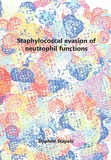Staphylococcal evasion of neutrophil functions

Stapels, Daphne
- Promoter:
- Prof.dr. J.A.G. (Jos) van Strijp
- Co-promoter:
- Dr. S.H.M. (Suzan) Rooijakkers
- Research group:
- Strijp , Rooijakkers
- Date:
- April 9, 2015
- Time:
- 14:30 h
Summary
Infections with the Gram-positive Staphylococcus aureus form an increasing problem in healthcare settingsand the community. Whereas it is long known that neutrophils are essential for fightingstaphylococcal infections, the role of their neutrophil serine proteases (NSPs) was believed tobe trivial. Nevertheless, in this thesis we show that S. aureus secretes a family of highly homologous extracellular adherence proteins (EAPs) that can all inhibit NSPs. Studies on protein structure revealed that inhibition is achieved by occlusion of the protease's catalytic cleft. Subsequent murine infection studies with isogenic eap-mutant strains showed that S. aureus uses the EAPs to protect its other virulence factors against degradation by NSPs. Therefore, future therapies aimed at disturbing the NSP inhibition by EAPs might restore the capacity of the immune system itself to dismantle the other staphylococcal virulence factors. In addition, we describe in this thesis that one of the EAPs (Eap) inhibits activation of the complement system in a mechanism unrelated to NSP inhibition. Namely, Eap inhibits complement activation via the classical (CP) and lectin pathways (LP) by binding to C4b. This is the first staphylococcal immune-evasion protein to target the CP/LP C3 convertase. Altogether, this thesis provides further insight into the molecular interplay between S. aureus and the host immune system. These insights might be used to initiate new angles of therapeutic development, either aimed at combating staphylococcal infections, or at the development of novel NSP inhibitors that might serve as therapeutics against inflammatory diseases.